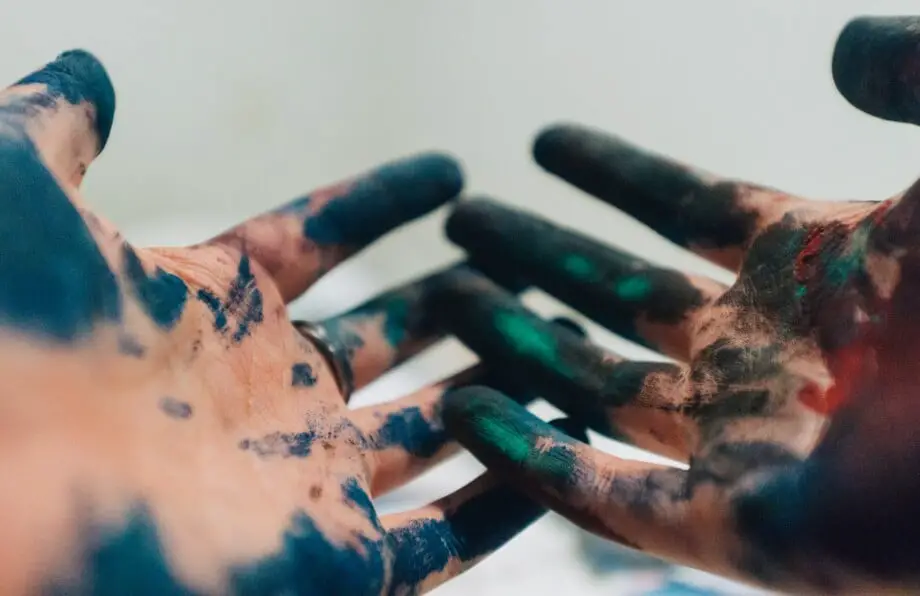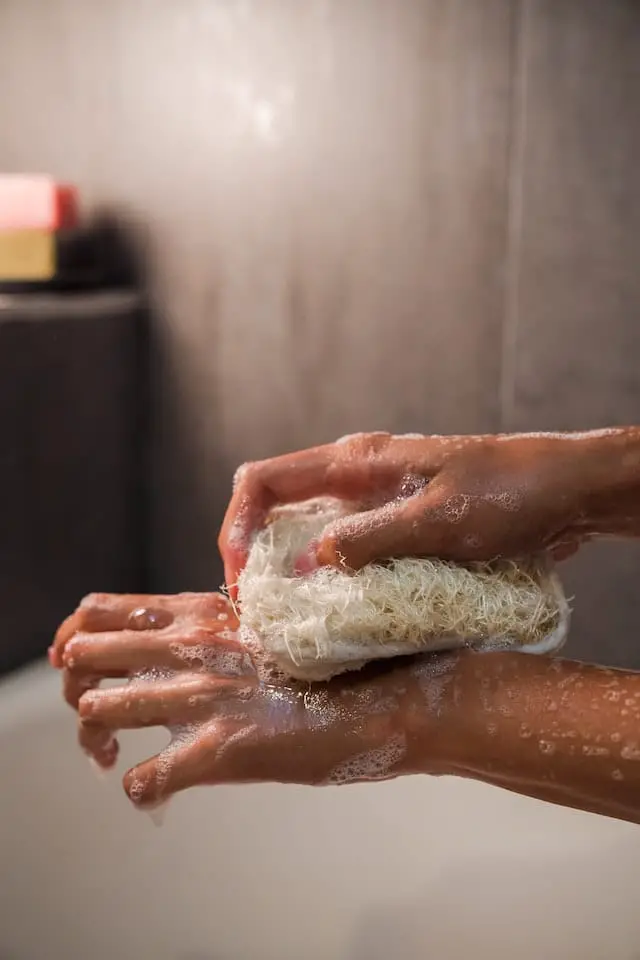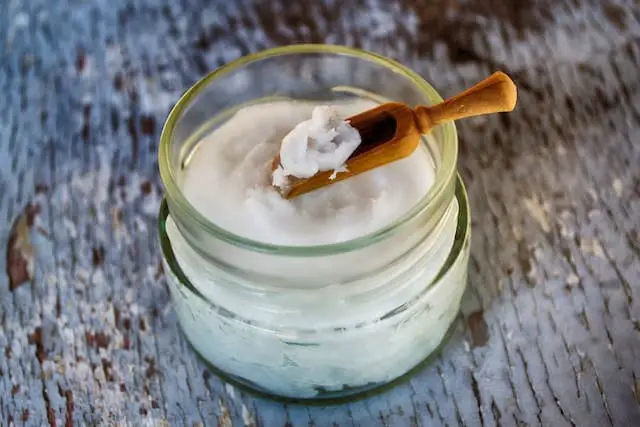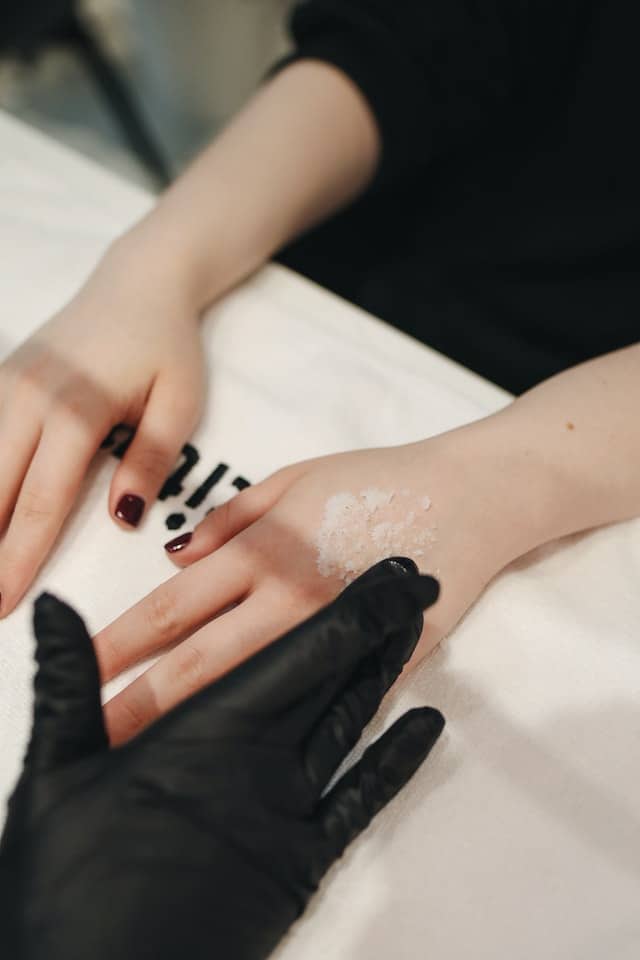Painting is fun- whether you do it on a canvas or your walls. But once the project is complete and you’ve admired your creation, you look down only to find your hands and nails covered in paint.
Understandably, your first instinct is to simply hit the shower and wash everything off, but I have been in the same position too many times to believe that would work.
As a rule of thumb, water-based paints are easier to remove than oil-based paints because they dissolve in water. Fortunately, I have quite a few tricks up my sleeve to help you get rid of oil and enamel paints as well.
You can remove oil-based paints with oil-based cleaners. Sounds simple enough?
You can start with a light layer of mineral or baby oil to rub off the paint from your skin. If that doesn’t work, you can try rubbing alcohol or nail polish remover. For tougher stains, I recommend using vegetable or cooking oils.
But these are just a few cleaners to help you get rid of paint from your face, hand, and nails. In the article, we will discuss several other options that work just as well.
So, stick around to find the fastest way to get paint off hands and nails.
Can you remove paint from the skin?
Yes, absolutely!
The best way to clean paint from your skin depends on the type of paint you’re dealing with. This is important because both types of paints require different cleaning methods.
Water-based paints require less effort as they dissolve in water, but oil-based paints are trickier and more time-consuming to clean.
| Pro tip: The skin on your face is more sensitive compared to your hands and nails, so be gentle with it. |
Let’s start with water-based paints.
How to get rid of water-based paint from skin and nails
Usually, paints are easier to remove while wet but water-based paints can be quickly cleaned even after they have dried. If you’re unsure whether your paint is water-based, here are a few examples to help you decide.
- Water-based paints include:
- Watercolors
- Latex interior and exterior paint (spray and liquid)
- Acrylic craft paint
- Finger paint
- Fabric paint

Now, let’s move on to paint removal methods.
Wash with water and soap
You should always begin with the gentlest cleaning method to avoid exposing your skin to unnecessarily harsh ingredients. Wet the skin with warm water and generously apply soap to the area. Work it into a lather and gently scrub away the paint using your hands or a washcloth.
You can repeat this method two to three times to completely remove any splatters of paint.
Use a pomace stone or salt
If you feel the water and soap aren’t working as well as you’d like, add some salt to the mix to add an element of abrasion. You can also use granulated sugar instead of salt- the idea is to give the paint a push with something harder.
If these natural ingredients aren’t effective, use a pomace stone or a soap bar containing ground pomace. Scrub the skin using gentle motions and rinse well.
Apply isopropyl alcohol
If the water-based paint has dried on the skin, you can dampen a cotton ball with isopropyl or rubbing alcohol and apply it lightly to the paint. Keep scrubbing the stain with the cotton ball for a few minutes until the color starts to dissolve.
Once the paint is wet with alcohol, try the above two steps to remove it altogether from your skin.

How to remove oil-based paint from skin
Oil-based paints can be challenging to remove, especially if they have dried on the skin. They can irritate your skin’s natural barrier because of the petroleum distillates it contains. Therefore, it’s best to act quickly and remove the paint before it damages your skin.
Turpentine and thinner and other mineral spirits are best for removing oil-based paints but aren’t the most skin-friendly. For this reason, you should exhaust other safer options first before jumping to these strong cleaners.
| PS: Have a look at a greater understanding of the difference between turpentine and thinner before using them on your skin. |
Use baby oil
Since oil-based paints can be cleaned using oil cleansers, this is the gentlest option of the lot. Apply some baby oil liberally on your skin using circular motions. Keep cleaning the dried paint with the oil until it starts to move around. It may take a few minutes to see visible results but stay patient.
Rinse and repeat a couple of times to get rid of paint splatters completely.
Try cooking spray
Removing oil-based paint with baby oil might test your patience so try cooking spray instead. Spray a thick layer of cooking spray on the paint-covered area. Rub the skin gently to move the paint, and keep spraying more as you scrub the previous layers off.
If you have managed to get a considerable amount of paint on your skin, you may need multiple sessions of cooking spray to get it off entirely.
Wash with dish soap
Dish soap is used to clean up oil spills in the kitchen, then why shouldn’t it work on oil-based paint?
After you’ve used a cooking spray or baby oil, you will be left with oil build-up on your skin. That’s when you can turn to your dish soap and clean the grease and oil off.
Dish soap contains mild cleaning agents that don’t harm the skin, so rest assured that even if the paint doesn’t come off, your skin will be just fine.
Clean with mayonnaise
Who would have thought your favorite sandwich spread could remove tough paint stains?
While this choice may sound surprising at first but just hear me out. Mayonnaise is made with oil, so it works similarly to other oil-based cleaning options. But the highlight of using mayo is that it can be cleaned up easily once you’re done because it’s not entirely oil-based.
It is a safe paint remover that should probably be your first or second choice. Since it’s so mild, it may not get the job done as well as other potent ingredients, but it’s a good place to start.
Petroleum jelly
Petroleum jelly can do much more than just hydrate your skin. It can be used to lift oil-based paints from your skin as well.
Since petroleum jelly has a mild formula, it’s perfect for sensitive skin. While it can be used on your hands, it’s ideal for cleaning paint off the face.
That being said, the mild formula may not be as effective at removing paint as the other options mentioned, but it’s a good start. Just make sure the jelly doesn’t spread paint onto other parts of the skin as you rub it in.

Use acetone
Acetone is the main ingredient in nail polish removers; therefore, it does a pretty decent job of removing paint from the skin. However, it is not a gentle cleaning agent and can cause adverse reactions on the skin.
Although it’s highly effective at getting rid of paint, I recommend using this method only after you’ve exhausted all the others.
Just make sure to use it sparingly to avoid getting your skin worked up. Wash it with warm water and soap immediately to minimize its harmful effects.
Make a paste of coconut oil and baking soda
You can mix 1 cup of coconut or any vegetable oil with ½ a cup of baking soda. Create a thick paste and apply it to the dried paint. Next, use toothpaste to gently scrub away the stain and continue until all the color has come off.
You can wash your skin with dish soap and warm water to remove paint residue and the grease from coconut oil.

Try Vick’s Vapor Rub
Did you know that Vick’s Vapor Rub contains turpentine oil? Well, it does, and that too in safer quantities. Therefore, you can use it to remove oil-based paint without aggravating your skin.
Cover the area you want to clean with a layer of Vick’s vapor rub and let it sit for a few minutes. Then gently wipe away the paint with a clean washcloth, some soap, and water.
How to remove paint from under fingernails
The worst side-effect of being an avid paint lover is paint-stained fingernails.
The problem with cleaning fingernails is that the skin underneath is very hard to reach; therefore, removing paint becomes tricky. Your best bet for cleaning your nails is to soften the dried paint first and then attempt to remove it.
If you’re working with water-based paints, any paint on your nails should wash right off with water and soap. In case it has dried down, you can use a sugar scrub or butter to soften the paint before washing it off.
However, if you need to clean oil-based paint, get ready for a long ride.
- Scratch as much paint as you safely can from your nails and the skin underneath them.
- Wash your hands thoroughly with soap and warm water.
- After drying your nails, apply a few drops of mineral oil to the dried paint and massage it in.
- Continue rubbing the paint for a minute to soften it.
- Use a soft-bristled brush (an old toothbrush can work too) to scrub the paint on top and underneath your nails. Remember to be gentle, as the skin under your nails is delicate.
- Wash your hands again with warm water and soap to remove all residue.
- Repeat the above process until your remove all the paint from your skin.
Mineral oil is just one option; you can also try the above methods to clean paint from your fingernails. Always start with the mild options first and use a chemical remover only when everything else fails.
| Pro Tip: Citrus fruits like grapefruit, lemon, and oranges contain natural acids that help remove paint. They’re also safe to use and won’t irritate your skin. |
Tips to keep paint off your skin
Removing paint from your face, hands, and nails is a time-consuming task that gets even more difficult when you’re tired from completing a paint job. So, instead of focusing on ‘how to remove paint from the skin,’ think about ‘how to prevent paint from getting on your skin.’
Here are a few handy tips you can use the next time you paint.
- Wear thin rubber or plastic gloves.
- Wear an old long-sleeved shirt with overalls or long pants.
- Use a paint roller guard to avoid paint splatters when painting.
- Add a pistol-grip handle to your spray can to minimize the staining of your trigger finger.
- Keep a wet cloth handy while you paint to remove any paint splatters immediately.
- Wear safety gear to protect your hair, face, hands, and clothes from accidental paint splashes.
FAQs
How long does it take for paint to come off the skin?
Water-based paints can come off in a single wash, but oil-based paints may need repeated washing and scrubbing. You can expect it to take two to three days to come off completely.
Does WD 40 remove paint from skin?
Yes, WD 40 can remove paint from the skin, but it has harmful chemicals that can cause an adverse reaction. That’s why you should stick to mild paint removers only.
What happens if you have paint on your skin?
Paint can block the pores on your skin, leading to acne, blemishes, and rashes. Any type of paint pigment prevents your skin from breathing, so you should wash it off entirely while it’s still wet.
Is wall paint toxic to skin?
Wall paints are usually safe, but prolonged exposure to them can sometimes cause skin irritation, a sore throat, and watery eyes.
Final verdict
If you’re someone who enjoys DIY paint jobs, you should make sure to cover your clothes and skin adequately to avoid any paint splatters. However, if you miss a spot, you can try any of the methods above to remove paint from your skin.
We have you covered even if you need help removing paint from your clothes, so check that out as well.


Itís hard to find experienced people about this topic, but you seem like you know what youíre talking about! Thanks
I blog frequently and I genuinely appreciate your content. The article has truly peaked my interest. I will take a note of your blog and keep checking for new details about once a week. I opted in for your RSS feed too.